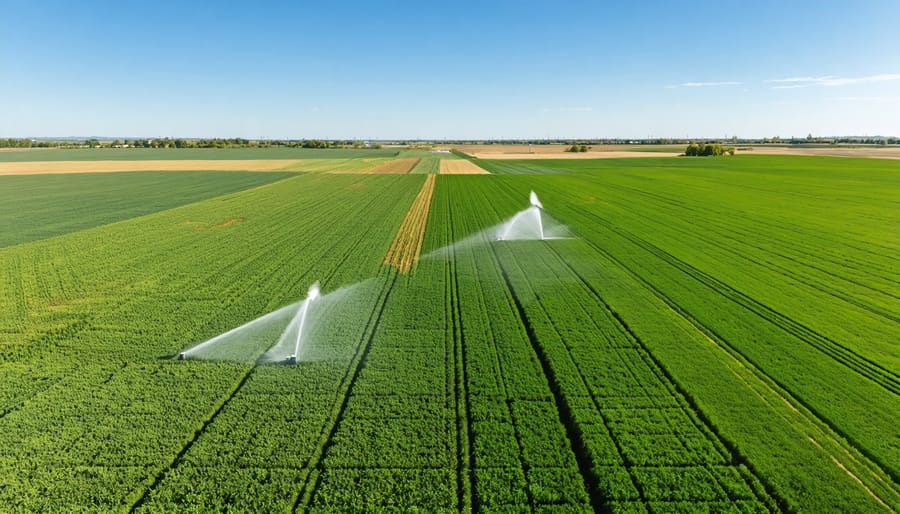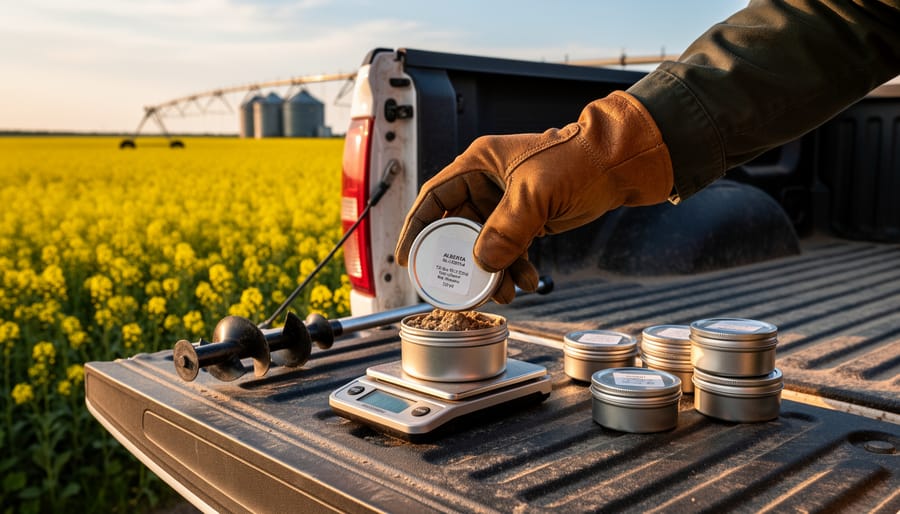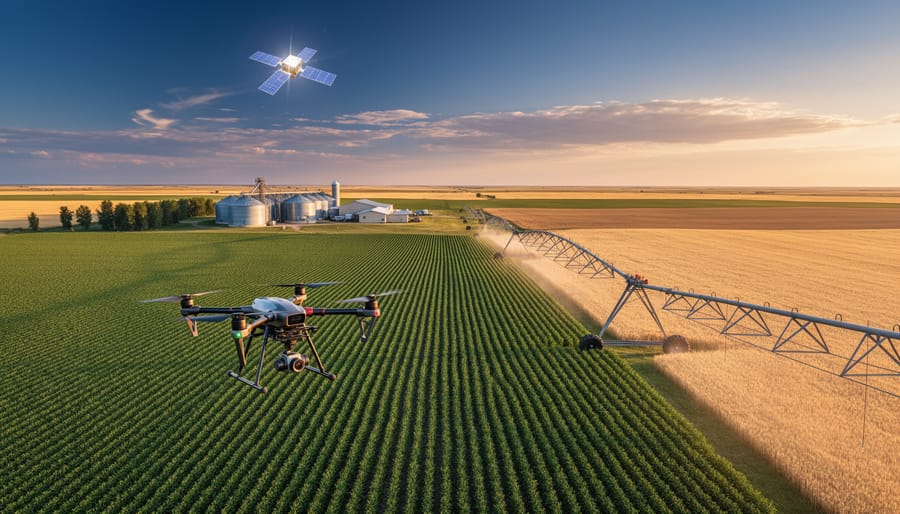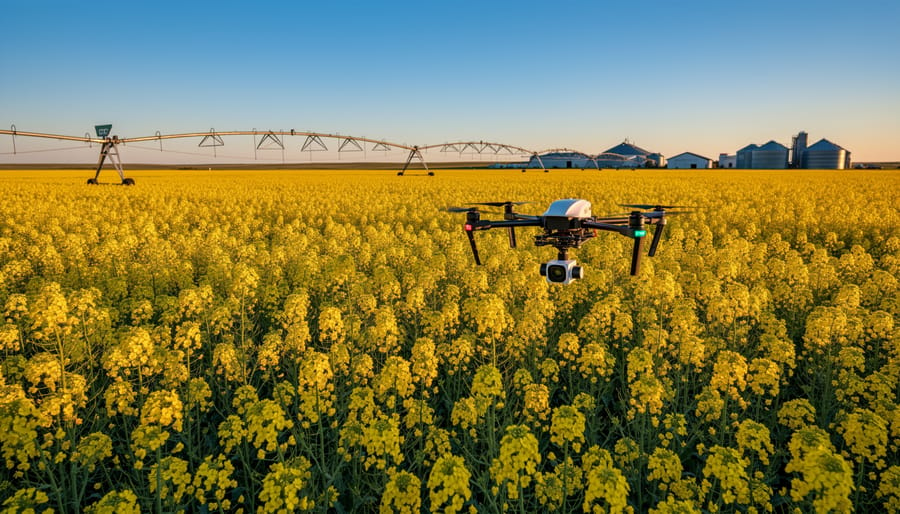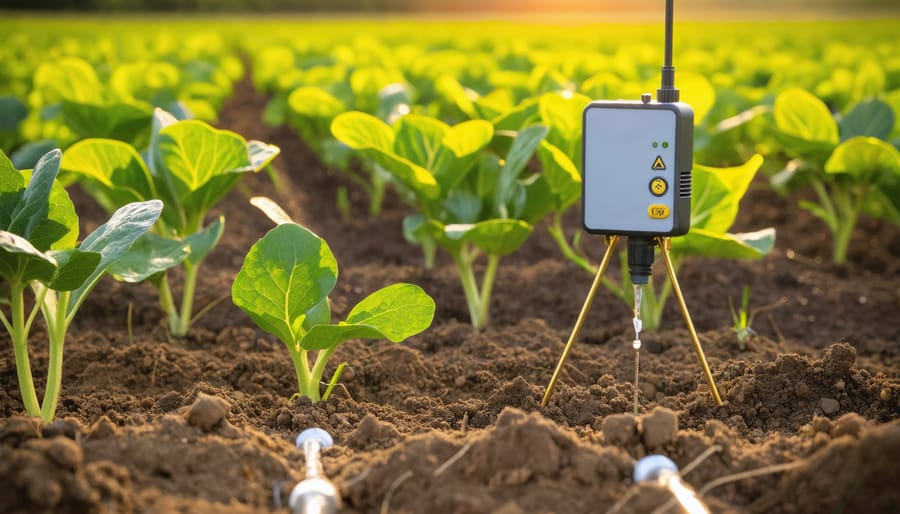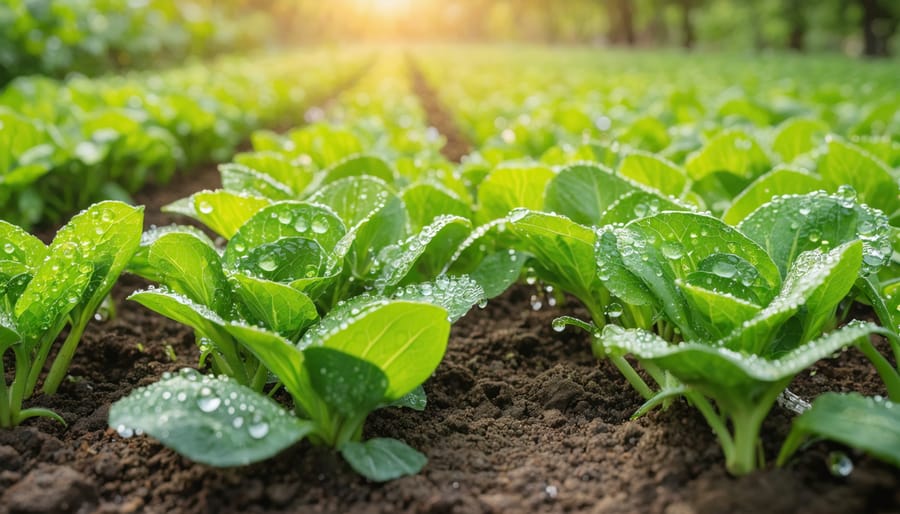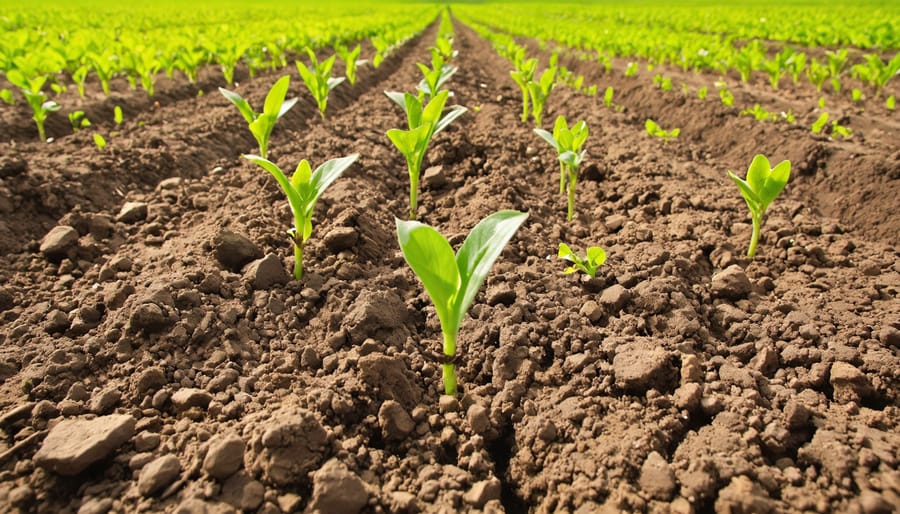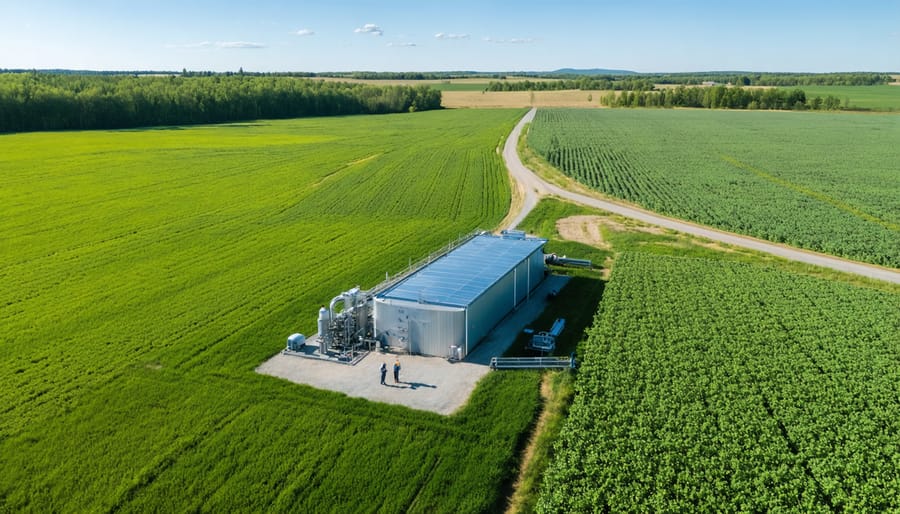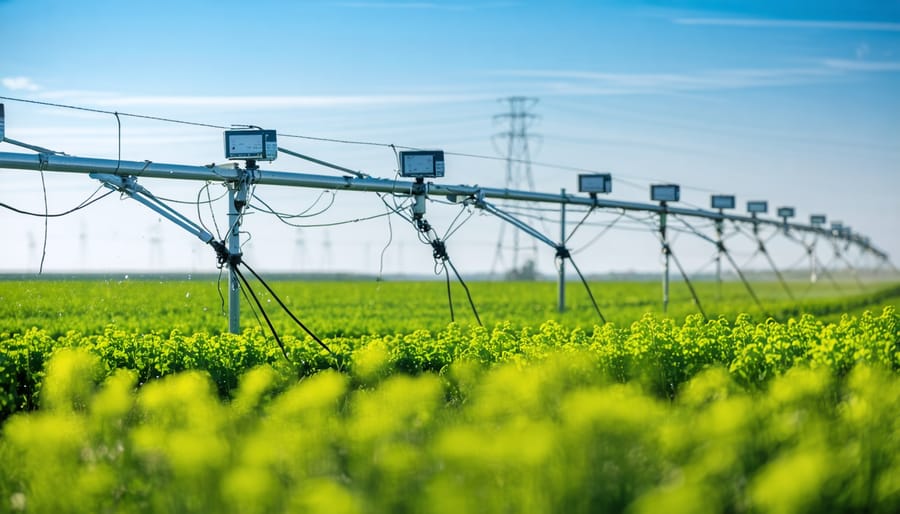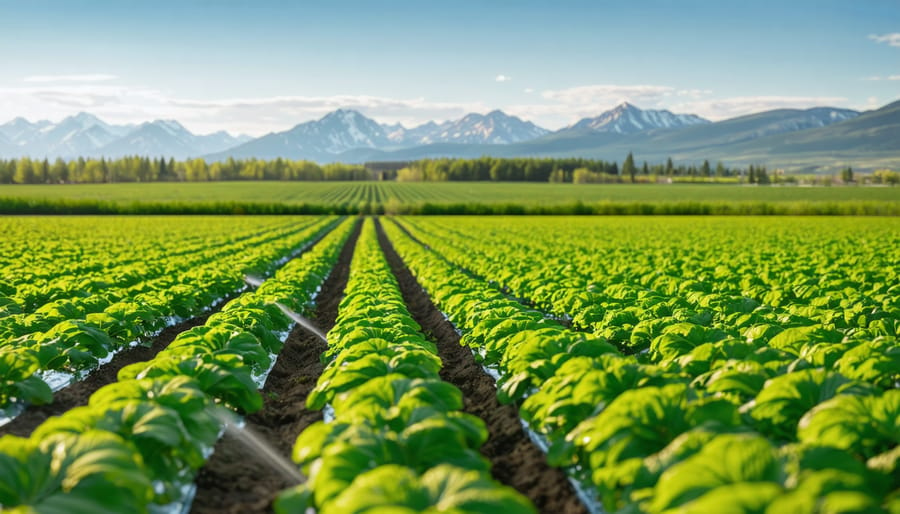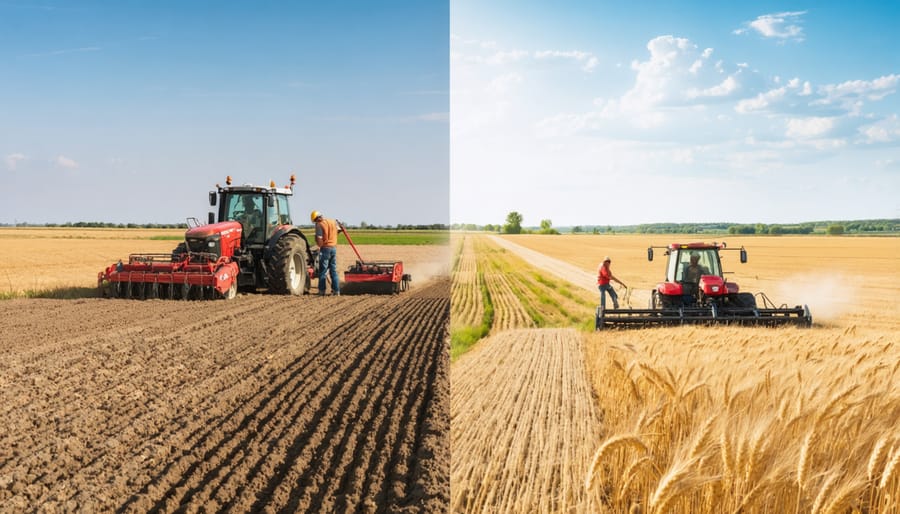Water scarcity affects 40% of Canadian agricultural operations, making conservation essential for sustainable farming and economic viability. Every drop saved translates to reduced operational costs and improved crop resilience, particularly across Alberta’s 50.3 million acres of farmland. Through proven techniques and modern innovation, farmers can cut water usage by 20-30% while maintaining or even improving yields.
Our agricultural experts have identified seven practical water conservation methods that have demonstrated success across diverse Canadian farming operations. These strategies combine traditional wisdom with cutting-edge technology, offering solutions for operations of any size. From simple adjustments in irrigation timing to advanced soil moisture monitoring systems, these methods represent the future of sustainable Canadian agriculture.
Whether you’re managing a large-scale grain operation in Saskatchewan or a small mixed farm in southern Alberta, these water conservation techniques can be adapted to your specific needs. By implementing these approaches, you’ll join thousands of Canadian farmers who are leading the way in responsible water stewardship while protecting their bottom line and ensuring long-term farm sustainability.
Let’s explore these seven proven methods that can transform your farm’s water efficiency starting today.
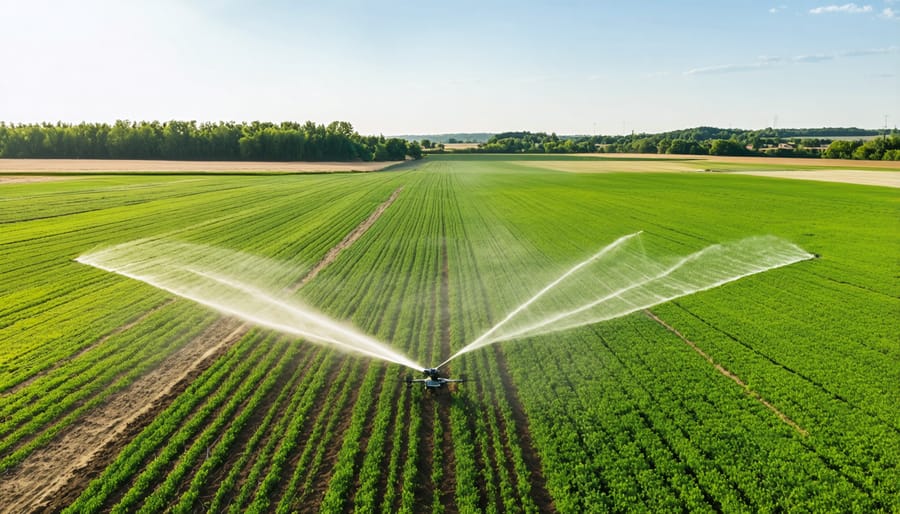
Precision Irrigation Systems
Soil Moisture Sensors
Modern soil moisture sensors are revolutionizing how Alberta farmers manage water resources. These smart devices, which integrate seamlessly with precision irrigation technology, provide real-time data about soil moisture levels at various depths, helping farmers make informed decisions about when and how much to irrigate.
By installing sensors at strategic locations across their fields, farmers can monitor moisture levels through user-friendly smartphone apps or computer dashboards. This data-driven approach has helped local producers reduce water usage by 20-30% while maintaining or even improving crop yields.
Many Alberta farmers have reported significant benefits after implementing these systems. For instance, the Thompson family farm in Lethbridge saved approximately 40 million litres of water in their first season using soil moisture sensors. The initial investment, which typically ranges from $2,000 to $5,000 for a basic system, usually pays for itself within two growing seasons through reduced water and energy costs.
For best results, consider placing sensors in areas with different soil types and topography to get a comprehensive picture of your field’s moisture distribution.
Smart Sprinkler Controls
Modern smart sprinkler control systems are revolutionizing how Alberta farmers manage irrigation. These intelligent systems use real-time weather data, soil moisture sensors, and crop-specific algorithms to deliver precisely the right amount of water when and where it’s needed.
Local farmer Mike Thompson from Lethbridge reports a 30% reduction in water usage since implementing smart controls on his canola fields. “The system automatically adjusts to rainfall forecasts and current soil conditions, something I used to do manually with much less precision,” he explains.
These systems typically include features like automated scheduling based on evapotranspiration rates, rain delay functions, and mobile app controls that allow farmers to manage irrigation from anywhere. Some advanced models even integrate satellite imagery to detect crop stress and adjust watering patterns accordingly.
Installation costs are often offset within two to three growing seasons through water savings and improved yield consistency. The Alberta Agriculture and Irrigation Ministry offers rebate programs for farmers transitioning to smart irrigation systems, making this technology increasingly accessible to operations of all sizes.
Remember to regularly calibrate sensors and update system settings as crop needs change throughout the growing season.
Drought-Resistant Crop Selection
Alberta-Adapted Varieties
Alberta’s unique climate demands crop varieties specifically bred for water efficiency. Local research stations have developed several drought-resistant options that thrive in our growing conditions while requiring minimal irrigation. The AC Strongfield durum wheat, developed at the Lethbridge Research Station, demonstrates excellent drought tolerance while maintaining high yield potential. Similarly, CDC Meadow yellow peas and AC Navigator barley have proven their resilience in dry conditions across southern Alberta.
These adapted varieties typically develop deeper root systems and possess enhanced water-use efficiency traits. For example, AAC Brandon wheat can produce competitive yields with up to 30% less irrigation than conventional varieties. Many Alberta farmers have reported success with these cultivars, particularly during challenging drought years.
Consider working with local seed suppliers and agricultural extension offices to identify the best-adapted varieties for your specific growing region and soil conditions. They can provide detailed performance data and help you make informed choices for water-conscious crop planning.
Crop Rotation Strategies
Strategic crop rotation is a cornerstone of water-efficient farming in Alberta’s diverse agricultural landscape. By alternating between deep-rooted crops like alfalfa and shallow-rooted vegetables, farmers can maximize soil moisture at different depths while improving overall water retention. This practice has shown remarkable results, with local farmers reporting up to 30% reduction in irrigation needs.
Consider implementing a three to four-year rotation cycle that includes drought-resistant pulses like lentils and chickpeas, followed by cereal crops and oilseeds. This sequence helps maintain soil structure and reduces water requirements throughout the growing seasons. Many Alberta farmers have found success by incorporating cover crops during transition periods, which protect soil moisture and prevent erosion.
For optimal results, match your rotation schedule with local precipitation patterns and soil conditions. Remember to factor in each crop’s water demands when planning your rotation sequence. This approach not only conserves water but also promotes healthier soil biology and reduces the need for synthetic inputs, creating a more sustainable farming system for future generations.
Soil Management Techniques
Cover Cropping
Cover cropping is one of the most effective soil moisture retention techniques available to Canadian farmers. By planting species like fall rye, clover, or winter wheat between main crop cycles, you create a living blanket that protects and enriches your soil. These cover crops develop deep root systems that improve soil structure and create channels for water infiltration, reducing runoff and evaporation losses.
In Alberta’s climate, where moisture conservation is crucial, cover crops can increase water holding capacity by up to 20%. Local farmers have reported significant reductions in irrigation needs after implementing cover cropping practices for just two seasons. The organic matter added by these crops also acts like a sponge, storing water for future use.
For best results, select cover crops that are well-adapted to your local conditions and timing your planting to maximize growth before winter. Consider mixing different species to create a diverse root system at various soil depths. This practice not only conserves water but also improves soil health, reduces erosion, and can provide additional revenue through grazing opportunities.
Mulching Practices
Proper mulching is a game-changer for water conservation on Canadian farms. By applying a 5-10 cm layer of organic mulch around your crops, you can reduce water evaporation by up to 70% while suppressing water-hungry weeds. Here in Alberta, many farmers have found success using locally-sourced materials like straw, wood chips, or composted manure.
Jim Anderson, a third-generation farmer from Lethbridge, shares: “Since implementing mulching practices, we’ve cut our irrigation needs by nearly 40% during the dry summer months. The soil stays moist longer, and our plants are healthier.”
For best results, apply mulch when the soil is already moist and warm, typically in late spring. Keep the mulch about 5 cm away from plant stems to prevent rot. In vegetable gardens, use finer materials like shredded leaves or grass clippings, while coarser materials like bark chips work well for perennial areas.
Remember to replenish your mulch annually or as needed – most organic mulches decompose over time, enriching your soil while conserving precious water resources.
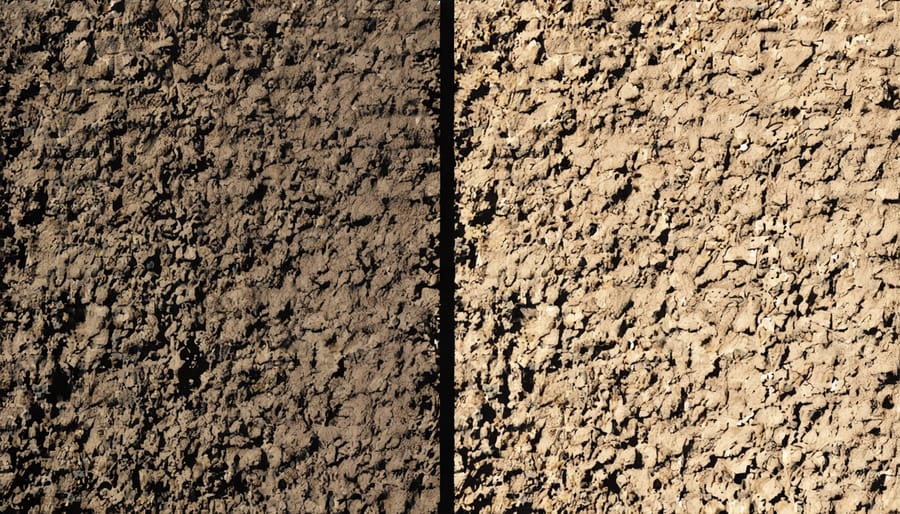
Water Recycling Systems
Rainwater Harvesting
For Alberta farmers facing unpredictable rainfall patterns, implementing effective rainwater harvesting systems can significantly reduce reliance on traditional water sources. Start by installing gutters and downspouts on farm buildings, connecting them to storage tanks or cisterns strategically placed to maximize collection. A 1,000-square-metre roof area can collect up to 1,000 litres of water for every millimetre of rainfall.
Consider installing first-flush diverters to prevent debris and contaminants from entering your storage system. For optimal results, use food-grade polyethylene tanks with UV protection, positioned on level, reinforced surfaces. Multiple tanks can be connected using a manifold system, allowing for greater storage capacity during peak rainfall periods.
Many Alberta farmers have successfully integrated these systems with drip irrigation setups, creating a sustainable water management cycle that’s particularly valuable during dry spells. Remember to regularly maintain your system by cleaning gutters, checking filters, and inspecting tanks for potential damage.
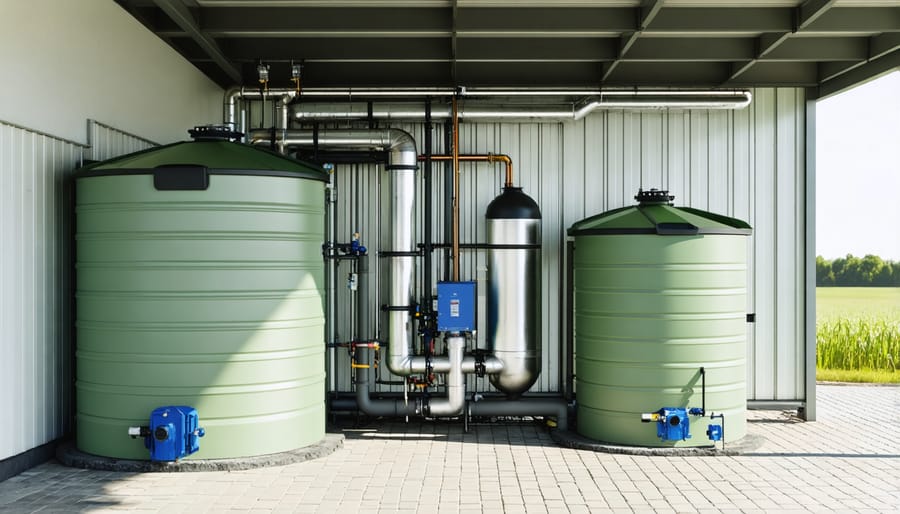
Greywater Reuse
Greywater reuse presents a sustainable solution for Alberta farmers looking to maximize their water efficiency. This practice involves collecting and treating household wastewater from sinks, showers, and washing machines for agricultural use. When properly managed, greywater can safely irrigate fodder crops, orchards, and certain field crops while reducing the demand on freshwater sources.
To implement a safe greywater system, start by separating greywater from blackwater (toilet waste). Install a basic filtration system to remove particles and consider using plant-based, biodegradable soaps to minimize soil impact. Many Alberta farmers report success with subsurface irrigation systems, which direct greywater beneath the soil surface, reducing exposure risks and maximizing absorption.
Remember to monitor soil health regularly when using greywater, as salt buildup can occur over time. Rotate irrigation between greywater and fresh water to maintain soil balance, and avoid using greywater on root vegetables or crops eaten raw. With proper management, greywater reuse can save up to 70,000 litres of water annually on a typical family farm.
Innovative Field Design
Contour Farming
Contour farming is a proven water conservation technique that’s delivering impressive results across Alberta’s rolling landscapes. By plowing and planting along the natural contours of your land, rather than in straight lines up and down slopes, you create natural barriers that slow water flow and increase soil retention. This method can reduce water runoff by up to 50% and soil erosion by 75% on moderate slopes.
Manitoba farmer James Thompson implemented contour farming on his 400-hectare property in 2019, reporting a 30% reduction in irrigation needs during the first season. “The difference was noticeable right away,” Thompson shares. “After spring rains, the moisture stayed where we needed it instead of running downhill.”
To get started, map your land’s elevation using GPS technology or consult with your local agricultural extension office. Begin with gentle slopes of 2-6% gradient, and consider combining this technique with strip cropping for maximum effectiveness. Remember to maintain your contour lines through regular monitoring and adjustment, especially after heavy rainfall events.
Wind Break Installation
Installing windbreaks on your farm can significantly reduce water loss through evaporation while protecting your crops from harsh prairie winds. Many Alberta farmers have found success using a combination of permanent and seasonal windbreaks. Permanent options include rows of native trees and shrubs, such as caragana or green ash, planted perpendicular to prevailing winds. For immediate protection, temporary windbreaks using annual crops like sorghum or tall wheat grass can be effective.
Studies from southern Alberta show that properly installed windbreaks can reduce evaporation by up to 30% in irrigated fields. They also help retain snow during winter months, providing additional soil moisture come spring. For best results, space multiple rows of windbreaks 100-200 metres apart, depending on your terrain and typical wind patterns.
Local conservation authorities often provide cost-sharing programs for windbreak establishment, making this a cost-effective water conservation strategy for your farm.
Monitoring and Maintenance
Equipment Inspection
Regular equipment inspection is your first line of defense against water waste on the farm. Schedule monthly checks of your irrigation systems, particularly during peak growing seasons from May to September. Look for leaks in pipes, damaged sprinkler heads, and clogged nozzles that could be compromising water efficiency.
Many Alberta farmers have found success with a systematic approach: create a maintenance checklist and keep detailed records of inspections and repairs. Start with pressure tests to identify potential issues early, and don’t forget to calibrate your water meters regularly – at least twice per growing season.
Consider investing in modern monitoring tools like soil moisture sensors and smart controllers. These devices can help identify irregularities in water distribution and prevent overwatering. Local irrigation specialists recommend checking system filters monthly and cleaning them as needed to maintain optimal performance.
Remember to inspect storage tanks and retention ponds for leaks or damage, especially after severe weather events. A well-maintained system can reduce water consumption by up to 30% compared to neglected equipment.
Water Usage Tracking
Tracking your farm’s water consumption is crucial for developing effective conservation strategies. Modern water usage monitoring systems can help you identify areas of waste and optimize irrigation schedules. Start by installing flow meters at key points in your irrigation system and maintain detailed records of daily water use. Many Alberta farmers have found success using smart meters that automatically log data and send alerts when usage patterns change unexpectedly.
Consider implementing a monitoring checklist that includes regular checks of soil moisture levels, weather forecasts, and crop water requirements. Digital soil moisture sensors can provide real-time data through your smartphone, helping you make informed decisions about when to irrigate. Track your water usage against local benchmarks and seasonal averages to better understand your farm’s efficiency.
Remember to document water savings achieved through various conservation methods – this data will help you demonstrate the value of your water stewardship efforts and identify areas for further improvement.
As we wrap up our journey through water conservation strategies, remember that every drop truly counts in sustaining Alberta’s agricultural future. These seven methods represent more than just water-saving techniques; they’re investments in your farm’s resilience and our province’s agricultural heritage.
From implementing efficient irrigation systems to selecting drought-resistant crops, each approach we’ve discussed can be tailored to your specific farming operation. The beauty of these methods lies in their scalability – whether you’re managing a small family farm or overseeing large-scale operations, these strategies can be adapted to suit your needs.
We’ve seen how fellow Alberta farmers have successfully implemented these practices, reducing their water usage by up to 30% while maintaining or even improving crop yields. Their experiences demonstrate that water conservation and profitable farming go hand in hand.
Remember, water conservation isn’t just about protecting our resources – it’s about building a sustainable future for Canadian agriculture. Start small by implementing one or two of these methods, then gradually incorporate others as you become comfortable with the changes. Connect with your local agricultural extension office or farming community for support and shared learning experiences.
Together, we can preserve our water resources while maintaining Alberta’s position as a leading agricultural region. Your efforts today will help ensure a thriving farming community for generations to come.

